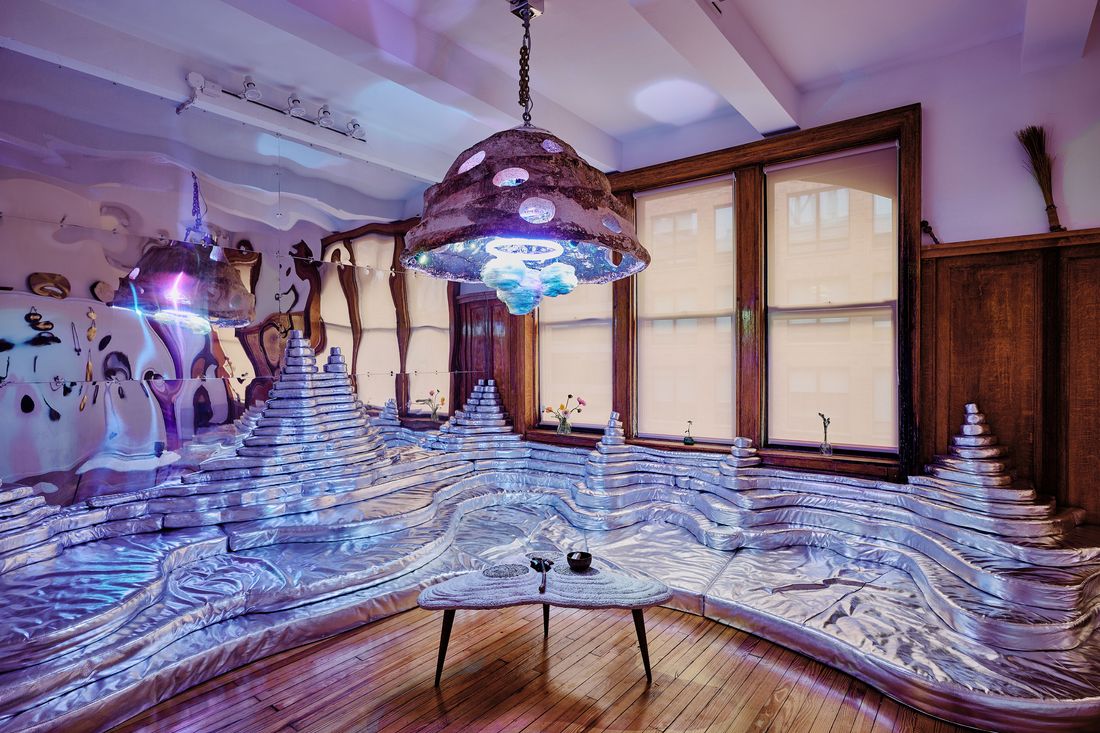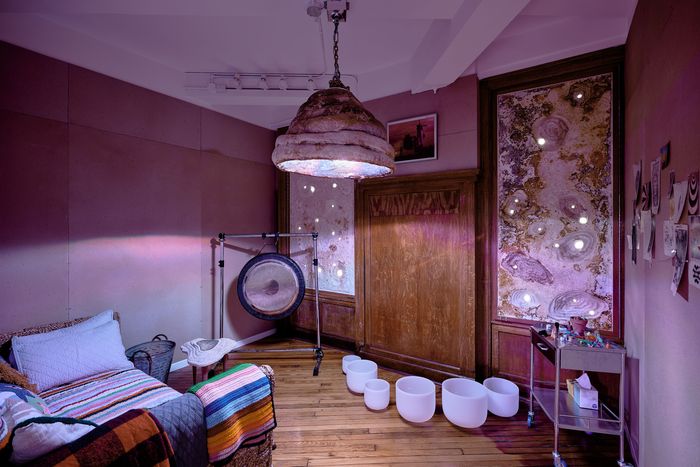
When artist and builder Randy Polumbo heard about the three-year-old “healing, recovery, and awakening” organization Cardea, which his friend Dimitri Mugianis founded, he wanted to help. Polumbo joined as a partner, pitching in on the new space on Canal Street, where they would hold sessions with clients involving the use of the drug ketamine. “I worked on things from negotiating the lease and picking space to the final build-out and furnishing the space, all with vintage items from my personal collection and other partners’ libraries of cool stuff, books, records,” he says. “And of course mushrooms.”
Polumbo thought it natural to work with reishi mushroom mycelium to create special pieces for the décor. It was a material he was already familiar with. “It’s all mycelium,” he says of the tables, light fixtures, and some of the window shutters: mushroom spores grown in molds populated with hemp straw or sawdust with flour for food, which turns into a Styrofoam or corklike material. “My studio turned into a mushroom lab, if you saw it now,” he says.
Mugianis describes himself as “Lead Dialogic Facilitator & Space Holder Ceremonialist.” The group also hosts psilocybin retreats in Jamaica. On Canal Street, the goal was to create “a calming, novel, and imaginative ‘holding space’ for transformative experiences. The space’s design materializes our concept of ‘radical hospitality.’”
“We believe strongly in what is called ‘set and setting,’” Mugianis explains via email. “Meaning that the ‘set’ of a person’s mental state and the ‘setting’ of the environment in which they journey (mainly the people who are holding space for them) is a central element in regard to the effectiveness of the actual substance the person takes. We are experts in helping a person get into the right mind for a journey and providing the right environment to journey well.”
Polumbo has been immersed in mushroom-materials study since the COVID lockdown. “I was growing mushrooms and mealworms that I have been studying over the last few years, then I was growing mushrooms and realized that the mycelium was super-interesting. People have been making things out of mycelium for decades: flowerpots and lampshades, kind of crafty stuff, but then I got deeply into it and did a project for the Brooklyn Museum made out of panels of mycelium.”
When you walk in, you face a fun-house mirror, the kind you’d see at Coney Island, which is in fact where Polumbo found it many years ago, stowing it with his trove of often odd objects in his Gowanus studio. Polumbo builds interesting, sometimes trippy environments: He restored a derelict lighthouse off Orient Point and turned it into an artist’s retreat, and built Spikehorn, a desert retreat, on 40 acres in California’s Joshua Tree.
At Cardea, there are three rooms where sessions using ketamine take place, named after “pioneers of play,” Mugianis explains. The Beatrice Wood Room is “where we do art-making with our guests, either prior to or following their ketamine sessions.” The Alice Coltrane Room, named after the jazz musician and swamini, is where guests listen to recordings created and produced by Cardea’s sound director, the electronic musician John MacLean — better known by his stage name, The Juan MacLean — over headphones. The Bootsy Collins Room is used for live sound sessions.
Finally, you reach the Mothership, a large room at the end of the office where lectures, events, and group sessions are held. It is here that Polumbo’s otherworldly design glistens and gleams, with a sliver moonscape of seating rising off the floor and a wall covered in polished aluminum.
According to Polumbo, “Mycelium is the underground, the understory of the mushroom people, the little mushroom that we think of as the mushroom, that’s like the rose is to the rosebush, the sex organ, the little pollen antennae. Most of the mushroom people live underground, and they can turn into this giant multi-, mile-long map that can communicate with other mushrooms and send messages and exchange nutrients with sapling trees that can’t reach the sun yet — kind of insane.”
More Great Rooms
- Just Follow the Red Door Through the Trees
- A Jubliantly Traditional Carnegie Hill Classic Six
- Object & Thing Goes to the Beach













